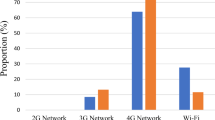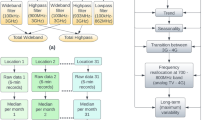Abstract
The aim of this study was to assess environmental and personal radiofrequency-electromagnetic field (RF-EMF) exposures in kindergarten children. Ten children and 20 kindergartens in Melbourne, Australia participated in personal and environmental exposure measurements, respectively. Order statistics of RF-EMF exposures were computed for 16 frequency bands between 88 MHz and 5.8 GHz. Of the 16 bands, the three highest sources of environmental RF-EMF exposures were: Global System for Mobile Communications (GSM) 900 MHz downlink (82 mV/m); Universal Mobile Telecommunications System (UMTS) 2100MHz downlink (51 mV/m); and GSM 900 MHz uplink (45 mV/m). Similarly, the three highest personal exposure sources were: GSM 900 MHz downlink (50 mV/m); UMTS 2100 MHz downlink, GSM 900 MHz uplink and GSM 1800 MHz downlink (20 mV/m); and Frequency Modulation radio, Wi-Fi 2.4 GHz and Digital Video Broadcasting-Terrestrial (10 mV/m). The median environmental exposures were: 179 mV/m (total all bands), 123 mV/m (total mobile phone base station downlinks), 46 mV/m (total mobile phone base station uplinks), and 16 mV/m (Wi-Fi 2.4 GHz). Similarly, the median personal exposures were: 81 mV/m (total all bands), 62 mV/m (total mobile phone base station downlinks), 21 mV/m (total mobile phone base station uplinks), and 9 mV/m (Wi-Fi 2.4 GHz). The measurements showed that environmental RF-EMF exposure levels exceeded the personal RF-EMF exposure levels at kindergartens.
This is a preview of subscription content, access via your institution
Access options
Subscribe to this journal
Receive 6 print issues and online access
$259.00 per year
only $43.17 per issue
Buy this article
- Purchase on Springer Link
- Instant access to full article PDF
Prices may be subject to local taxes which are calculated during checkout



Similar content being viewed by others
References
Bhatt CR, Redmayne M, Abramson MJ, Benke G . Instruments to assess and measure personal and environmental radiofrequency-electromagnetic field exposures. Australas Phys Eng Sci Med 2016; 39: 29–42.
Interphone Study Group. Brain tumour risk in relation to mobile telephone use: results of the INTERPHONE international case–control study. Int J Epidemiol 2010; 39: 675–694.
Abramson MJ, Benke GP, Dimitriadis C, Inyang IO, Sim MR, Wolfe RS et al. Mobile telephone use is associated with changes in cognitive function in young adolescents. Bioelectromagnetics 2009; 30: 678–686.
Schoeni A, Roser K, Röösli M . Memory performance, wireless communication and exposure to radiofrequency electromagnetic fields: a prospective cohort study in adolescents. Environ Int 2015; 85: 343–351.
Miyakoshi J Cellular biology aspects of mobile phone radiation. In: Lin JC (ed). Advances in Electromagnetic Field in Living Systems: Health Effects of Cell Phone Radiation, vol 5. Springer: New York, NY, USA. 2009, pp 1–33.
Benson VS, Pirie K, Schüz J, Reeves GK, Beral V, Green J . Mobile phone use and risk of brain neoplasms and other cancers: prospective study. Int J Epidemiol 2013; 42: 792–802.
Frei P, Poulsen AH, Johansen C, Olsen JH, Steding-Jessen M, Schüz J . Use of mobile phones and risk of brain tumours: update of Danish cohort study. BMJ 2011; 343: d6387.
Thomas S, Benke G, Dimitriadis C, Inyang I, Sim MR, Wolfe R et al. Use of mobile phones and changes in cognitive function in adolescents. Occup Environ Med 2010; 67: 861–866.
Valentini E, Ferrara M, Presaghi F, De Gennaro L, Curcio G . Republished review: systematic review and meta-analysis of psychomotor effects of mobile phone electromagnetic fields. Postgrad Med J 2011; 87: 643–651.
Guxens M, van, Eijsden M, Vermeulen R, Loomans E, Vrijkotte TGM, Komhout H et al. Maternal cell phone and cordless phone use during pregnancy and behaviour problems in 5-year-old children. J Epidemiol Community Health 2013; 67: 432–438.
Baan R, Grosse Y, Lauby-Secretan B, El Ghissassi F, Bouvard V, Benbrahim-Tallaa L et al. Carcinogenicity of radiofrequency electromagnetic fields. Lancet Oncol 2011; 12: 624–626.
van Deventer E, van Rongen E, Saunders R . WHO research agenda for radiofrequency fields. Bioelectromagnetics 2011; 32: 417–421.
Bolte JFB, Eikelboom T . Personal radiofrequency electromagnetic field measurements in the Netherlands: exposure level and variability for everyday activities, times of day and types of area. Environ Int 2012; 48: 133–142.
Frei P, Mohler E, Neubauer G, Theis G, Burgi A, Frohlich J et al. Temporal and spatial variability of personal exposure to radio frequency electromagnetic fields. Environ Res 2009; 109: 779–785.
Gajsek P, Ravazzani P, Wiart J, Grellier J, Samaras T, Thuroczy G . Electromagnetic field exposure assessment in Europe radiofrequency fields (10 MHz–6 GHz). J Expo Sci Environ Epidemiol 2013; 25: 37–44.
Joseph W, Frei P, Röösli M, Thuróczy G, Gajsek P, Trcek T et al. Comparison of personal radio frequency electromagnetic field exposure in different urban areas across Europe. Environ Res 2010; 110: 658–663.
Urbinello D, Joseph W, Huss A, Verloock L, Beekhuizen J, Vermeulen R et al. Radio-frequency electromagnetic field (RF-EMF) exposure levels in different European outdoor urban environments in comparison with regulatory limits. Environ Int 2014; 68c: 49–54.
Urbinello D, Huss A, Beekhuizen J, Vermeulen R, Röösli M . Use of portable exposure meters for comparing mobile phone base station radiation in different types of areas in the cities of Basel and Amsterdam. Sci Total Environ 2014; 468–469: 1028–103319.
Urbinello D, Röösli M . Impact of one’s own mobile phone in stand-by mode on personal radiofrequency electromagnetic field exposure. J Expo Sci Environ Epidemiol 2013; 23: 545–548.
Vermeeren G, Markakis I, Goeminne F, Samaras T, Martens L, Joseph W . Spatial and temporal RF electromagnetic field exposure of children and adults in indoor micro environments in Belgium and Greece. Prog Biophys Mol Biol 2013; 113: 254–263.
Juhász P, Bakos J, Nagy N, Janossy G, Finta V, Thuroczy G . RF personal exposimetry on employees of elementary schools, kindergartens and day nurseries as a proxy for child exposures. Prog Biophys Mol Biol 2011; 107: 449–455.
Gandhi OP . Yes the children are more exposed to radiofrequency energy from mobile telephones than adults. IEEE Access 2015; 3: 985–988.
Morris RD, Morgan LL, Davis D . Children absorb higher doses of radio frequency electromagnetic radiation from mobile phones than adults. IEEE Access 2015; 3: 2379–2387.
Joseph W, Frei P, Röösli M, Vermeeren G, Bolte J, Thuroczy G et al. Between-country comparison of whole-body SAR from personal exposure data in Urban areas. Bioelectromagnetics 2012; 33: 682–694.
Redmayne M, Johansson O . Radiofrequency exposure in young and old: different sensitivities in light of age-relevant natural differences. Rev Environ Health 2015; 30: 323–335.
Foster KR, Chou C-K . Are children more exposed to radio frequency energy from mobile phones than adults? IEEE Access 2014; 2: 1497–1509.
Chapman S, Wutzke S . Not in our back yard: media coverage of community opposition to mobile phone towers — an application of Sandman's outrage model of risk perception. Aust N Z J Public Health 1997; 21: 614–620.
Burgess A . Comparing national responses to perceived health risks from mobile phone masts. Health Risk Soc 2002; 4: 175–188.
Redmayne M . International policy and advisory response regarding children’s exposure to radio frequency electromagnetic fields (RF-EMF). Electromagn Biol Med 2016; 35: 176–185.
Calvente I, Pérez‐Lobato R, Núñez MI, Ramos R, Guxens M, Villalba J et al. Does exposure to environmental radiofrequency electromagnetic fields cause cognitive and behavioral effects in 10‐year‐old boys? Bioelectromagnetics 2016; 37: 25–36.
Care for kids. Available at: https://www.careforkids.com.au/ (last accessed 14 February 2015).
ICNIRP . ICNIRP guidelines for limiting exposure to time-varying electric, magnetic and electromagnetic fields (up to 300 GHz). Health Phys 1998; 74: 494–522.
Roser K, Schoeni A, Bürgi A, Röösli M . Development of an RF-EMF exposure surrogate for epidemiologic research. Int J Environ Res Public Health 2015; 12: 5634–5656.
Australian Radiofrequency Spectrum Plan 2013. Available at: http://www.acma.gov.au/~/media/Spectrum%20Transformation%20and%20Government/Information/pdf/Australian%20Radiofrequency%20Spectrum%20Plan%202013.pdf (last accessed 17 February 2016).
Radio Frequency National Site Archive. Available at: http://www.rfnsa.com.au/nsa/index.cgi (last accessed 12 January 2016).
Ganser GH, Hewett P . An accurate substitution method for analyzing censored data. J Occup Environ Hyg 2010; 7: 233–244.
Hewett P, Ganser GH . A comparison of several methods for analyzing censored data. Ann Occup Hyg 2007; 51: 611–632.
Tekindal MA, Erdoğan BD, Yavuz Y . Evaluating left-censored data through substitution, parametric, semi-parametric, and nonparametric methods: a simulation study. Interdiscip Sci 2015 (doi:10.1007/s12539-015-0132-9).
Huynh T, Ramachandran G, Banerjee S, Monteiro J, Stenzel M, Sandler DP et al. Comparison of methods for analyzing left-censored occupational exposure data. Ann Occup Hyg 2014; 58: 1126–1142.
Radiation Protection Standard. Maximum Exposure Levels to Radiofrequency Fields — 3 kHz to 300 GHz, Radiation Protection Series Publication No. 3. Australian Radiation Protection and Nuclear Safety Agency: Australia, 2002, pp 1–128.
Urbinello D, Joseph W, Verloock L, Martens L, Röösli M . Temporal trends of radio-frequency electromagnetic field (RF-EMF) exposure in everyday environments across European cities. Environ Res 2014; 134: 134–142.
Bhatt CR, Thielens A, Redmayne M, Abramson MJ, Billah B, Sim MR et al. Measuring personal exposure from 900 MHz mobile phone base stations in Australia and Belgium using a novel personal distributed exposimeter. Environ Int 2016; 92–93: 388–397.
Thielens A, Agneessens S, Verloock L, Tanghe E, Rogier H, Martens L et al. On-body calibration and processing for a combination of two radio-frequency personal exposimeters. Radiat Prot Dosimetry 2015; 163: 58–69.
Bergqvist U, Friedrich G, Hamnerius Y et al Mobile telecommunication base stations–exposure to electromagnetic fields. Report of a short term mission within COST-244bis. Available at: ftp://ftp.cordis.lu/pub/ist/docs/ka4/cost_244_base_station_emf.pdf (last accessed 12 January 2016).
Schmid G, Preiner P, Lager D, Uberbacher R, Georg R . Exposure of the general public due to wireless LAN applications in public places. Radiat Prot Dosimetry 2007; 124: 48–52.
Röösli M, Frei P, Bolte J, Neubauer G, Cardis E, Feychting M et al. Conduct of a personal radiofrequency electromagnetic field measurement study: proposed study protocol. Environ Health 2010; 9: 23.
Röösli M, Frei P, Mohler E, Braun-Fahrlander C, Burgi A, Frohlich J et al. Statistical analysis of personal radiofrequency electromagnetic field measurements with nondetects. Bioelectromagnetics 2008; 29: 471–478.
Henderson S, Tjong L, Wijayasinghe D . Survey of radiofrequency radiation levels across Melbourne. In: The 39th Australasian Radiation Protection Society Conference, Hobart, Tasmania, Australia, 2014.
Author information
Authors and Affiliations
Corresponding author
Ethics declarations
Competing interests
Michael J. Abramson holds a small parcel of shares in Telstra, which operates a mobile telephone network in Australia. The other authors declare no conflict of interest.
Rights and permissions
About this article
Cite this article
Bhatt, C., Redmayne, M., Billah, B. et al. Radiofrequency-electromagnetic field exposures in kindergarten children. J Expo Sci Environ Epidemiol 27, 497–504 (2017). https://doi.org/10.1038/jes.2016.55
Received:
Accepted:
Published:
Issue Date:
DOI: https://doi.org/10.1038/jes.2016.55
Keywords
This article is cited by
-
Instruments to measure environmental and personal radiofrequency-electromagnetic field exposures: an update
Physical and Engineering Sciences in Medicine (2022)
-
Wi-fi related radiofrequency electromagnetic fields (RF-EMF): a pilot experimental study of personal exposure and risk perception
Journal of Environmental Health Science and Engineering (2021)



